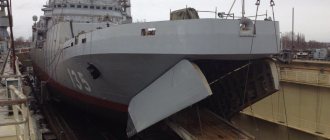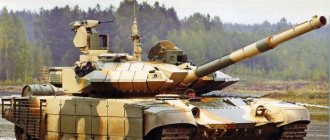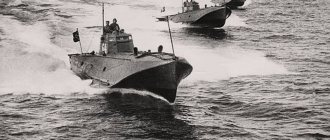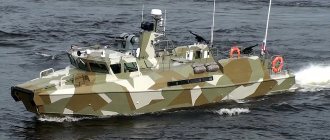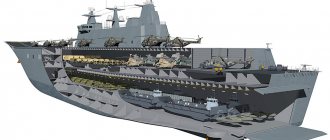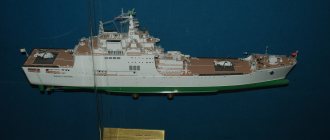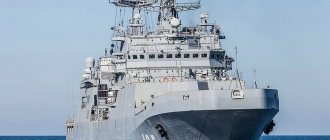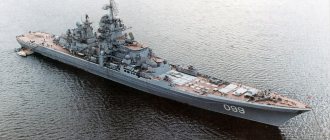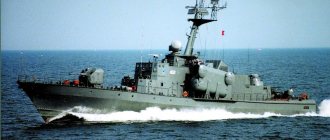Project development
In 1998, the Nizhny Novgorod “Central Design Bureau for Hydrofoils named after R. E. Alekseev” prepared a project for a high-speed landing boat of the “Shelf” type, designed to transport 3 infantry fighting vehicles or armored personnel carriers.
But due to financial difficulties and lack of an order from the Navy, the project was not implemented. With the advent of the 2000s, it became obvious that the modern fleet needs faster ships with significant landing capacity and carrying capacity. This led to the reworking of the initial project using developments from Project 11770 “Chamois”. This is how a new project of a transport-landing boat for operations in the seas and on large lakes in countries with different climatic conditions on an air cavity with a propulsion installation appeared, which received the code “Dugong”.
According to Andrei Shcherban, deputy head of the surface ships department of the Ministry of Defense department for ensuring state defense orders, it is planned to have 4-5 such ships in each fleet.
In 2011, the Commander-in-Chief of the Russian Navy decided to perpetuate the memory of the officers of the Guards naval crew who distinguished themselves in combat operations with foreign invaders and traveled from Smolensk and Borodino to Paris during the Patriotic War of 1812 in the names of landing boats of this series.
Landing boats of project 21820 "Dugong"
Landing boats of project 21820 code "Dyugon" (according to NATO codification - Dyugon) are a series of the latest Russian airborne landing boats, the lead ship of the series is the boat - D-105 "Ataman Platov". Currently, it is the only ship built according to this project and is part of the Caspian flotilla. Today, there are 2 more boats of this project under construction - one is being built at JSC Vostochnaya Verf in Vladivostok, the second at JSC Shipbuilding in Nizhny Novgorod. Also in 2011, a contract was signed for the construction of a series of 3 landing boats of Project 21820 at Yaroslavl Shipyard OJSC. The first of three ships of this series was laid down at the YASSZ on January 18, 2012, the ship received the name “Denis Davydov”. The lead boat of this project was laid down in 2006 and since 2010 has been part of one of the formations of the Caspian flotilla and received the name “Ataman Platov” in honor of the commander of the Great Don Army, whose regiments entered Paris in 1814 and “gave” the French capital a new type of catering establishments - bistro (from the Russian word “quickly”), since the Cossacks in Parisian cafes demanded to be served as quickly as possible. It is worth noting that the landing boats laid down in Yaroslavl will receive the names of heroes of the Patriotic War of 1812, which seems truly relevant in the year of its 200th anniversary. Three boats being built in Yaroslavl will be named Denis Davydov, Lieutenant Rimsky-Korsakov and Midshipman Lermontov. The last two were members of the Marine Guards crew and took part in the 1812 campaign.
The Project 21820 landing craft "Dugong" was developed in Nizhny Novgorod by specialists from the Central Design Bureau for Hydrofoils named after. R. E. Alekseeva. This design bureau specializes in the field of scientific research, design and creation of high-speed ships, vessels and boats with dynamic support principles. The designers and scientists of this design bureau created ekranoplan ships that have no analogues in the world, or as they are also called – “Caspian monsters”. These are the missile "Lun" and the transport-landing "Orlyonok", which were capable of reaching speeds of up to 500 km/h during the main mode of movement. According to projects created at the Central Design Bureau for Hydrofoils named after. R. E. Alekseev produced more than 8,000 hydrofoil ships for both civil and military purposes.
Currently, speed plays an increasingly important role during landing operations. The faster equipment and troops are delivered to the bridgehead, the greater the chance that success in this direction will be developed. The experience that Russian sailors gained while using the Serna landing boats of Project 11770 once again confirmed this axiom. But something else has become obvious: today, even faster ships with greater landing capacity and carrying capacity are required as independent combat units. At the same time, the amphibious and mobile characteristics of the new ships had to correspond to the similar characteristics of Project 11770 boats. These circumstances became the impetus for the creation of a new airborne transport and landing boat, which became the Project 21820 boat “Dugong”.
The total displacement of landing boats on an air cavern of the "Dugong" type is 280 tons, maximum length - 45 meters, maximum width - 8.5 meters, draft - 1.9 meters. The maximum speed is 35 knots at a wave height of 0.75 meters. The ship can also be used in stormy conditions with a wave height of no more than 3.5 meters. Project 21820 landing boats are equipped with two M507A-2D diesel engines with a power of 9,000 hp each. every. The maximum cruising range is 500 nautical miles. The dimensions of the cargo hold are 27x6.8x2.34 meters, the maximum carrying capacity is 140 tons, the landing craft can carry up to 3 MBTs or 5 armored personnel carriers.
In the control system of the landing boat "Dugong", together with the marine information and computing complex MIVK 6P-08B, the GKU-5 gyro direction indicator, the LI2 1 lag and engines that are equipped with tachometers of the TE-204 type, the autopilot "Agat-M3" (development and produced by NPP ANFAS, Saratov). In this case, it is possible to use the modernized autopilot “change 4”.
The landing craft's propulsion and steering complex, which includes a ventilated water-jet propulsion unit, does not protrude beyond the dimensions of the vessel's hull and allows for efficient operation in clogged waters and shallow waters. The crew of the landing ship is 6 people. The landing craft has weapons. As standard, it consists of 2 heavy-caliber 14.5-mm MTPU machine guns, as well as 8 Igla-type MANPADS. At the request of the customer, the composition and configuration of weapons can be changed.
The ships of this project, in particular the only landing craft in service, the Ataman Platov, confirmed their fairly high combat characteristics as part of the Center-2011 strategic maneuvers, which also took place in the Caspian Sea. As part of the exercise, the landing craft quickly delivered armored vehicles and marines to the battlefield and landed them on the unequipped coast.
It is reported that these vessels can be used together with landing helicopter dock ships of the Mistral project, which are being built today for the Russian Navy. Tank-landing boats of projects 11770 "Serna" and 21820 "Dugong" are fully suitable for the Mistrals in terms of their weight and size characteristics. Such boats, together with the Mistral aviation group, are designed to deliver weapons and landing forces of the dock ship to the shore.
Currently, the construction of Project 21820 ships for the needs of the Russian Navy continues. And the Central Clinical Hospital for SPK named after. R. E. Alekseeva continues to work on improving the boats of this project and creating new modifications. All of them differ from each other in their main power plants, layout solutions, propulsors, speed and displacement. But at the same time, all of them are perfectly suited for use in landing operations in enclosed and semi-enclosed seas, bays and archipelagic waters.
Sources of information: -https://www.oborona.ru/includes/periodics/navy/2011/1121/19587666/detail.shtml -https://militaryrussia.ru/blog/topic-630.html -https:// en.wikipedia.org
Service history
Landing during exercises
In 1991, 10 boats of this type joined the Black Sea Fleet. One boat (D-305, 1979) was transferred to the Ukrainian Navy in the early 1990s. In the list of ships of the Ukrainian Naval Forces, the dry cargo barge “Svatove” is listed. As of March 23, 2014, it is based in Ochakov.
As of 2015, the 100th brigade of landing ships of the Pacific Fleet, stationed in Fokino, still has three boats that are actively used during exercises when landing on training grounds. One of the boats annually participates in a theatrical show on Navy Day in Vladivostok, as a sea dragon.
Landing craft
The landing craft is the younger brother of a combat ship (UDC), designed to transport military equipment and drop off amphibious assault forces. It is so convenient that it is part of the main fleets of the world. Its history of creation is connected with the fact that in the First World War, ships could hardly approach unequipped shores for the transfer of personnel and weapons. Therefore, after the war, representatives of the fleet began to think about creating special watercraft that could deliver combat cargo and soldiers to the shore without a pier or other means necessary for berthing. So in the late 1930s, British designers designed a combat boat of the MLC type. Subsequently, the spread of the boat to other countries changed its name. In Germany it was called a sea landing barge. Britain designated it as a mechanized landing craft, and in the United States the boat was called an auxiliary landing craft. This did not change the essence of the floating craft. Already by the beginning of the Second World War, almost all the main participating countries had a boat of this type in their fleets. For the Soviet Union, the project became possible only in the post-war years.
Landing craft type LCM 6 (USA)
Landing capabilities
The reinforced hull, shallow draft and flat bottom of the boat make it possible to refloat without any help. It is relatively small in size and quite mobile. Due to its characteristics, it can easily approach the very shore in shallow water or swim into hard-to-reach places on the coast, for example, hidden beaches or coves. This allows you to land amphibious assault groups and weapons without giving away your location.
Mobile ships can transport 1-2 tanks or up to 7 armored vehicles. Or it can carry up to 200 armed Marines.
Service history
"D-144" was built in 2007 at the Shipbuilding Plant in Nizhny Novgorod, and in the same year it was transferred to Novorossiysk for acceptance tests. The crew of this landing boat (5 people) was formed and trained at the Caspian Flotilla, where by that time there were already landing craft of this project. On February 19, 2008, the landing boat "D-144" raised the St. Andrew's flag and became part of the Black Sea Fleet of the Russian Federation.
As of January 2009, 4 boats of this project were in service with the Caspian Flotilla, one boat was in service with the Russian Black Sea Fleet, and another boat was in service with the Baltic Fleet.
On October 8, 2010, the new landing boat “D-107” code “Serna” was put at the disposal of the Pacific Fleet. The new boat will be part of a landing ship formation based in Strelok Bay. The D-107 landing craft was laid down at the Eastern Shipyard slipway in Vladivostok on December 11, 2008, launched on April 15, 2010, and the ship was presented for state testing on May 30, 2010.
The newest landing boat "Denis Davydov" successfully completed state tests
Carrying out tests / Photo: Press service of the RF Ministry of Defense.
The newest landing boat “Denis Davydov” has successfully completed state tests and is preparing to be transferred to the Baltic Fleet, the press service of the Western Military District for the Baltic Fleet reported on Friday.
In the near future, the boat will undergo an inspection, and then, after signing the acceptance certificate with the customer, the Naval flag will be raised on the ship and it will become part of the landing ships of the Baltic Fleet.
“The newest landing craft of Project 21820 Denis Davydov, built for the Baltic Fleet at the Yaroslavl Shipyard, has completed state tests at the sea ranges of the Baltic Fleet,” the statement says.
Testing / Photo: Press services of the Russian Defense Ministry
During the tests, the crew of the boat checked the maneuverability and speed of the boat, the operation of all units, systems and components, navigation and radio equipment. Members of the selection committee also checked the ship's weapons - artillery firing was carried out at surface and air targets.
Currently, two more similar landing boats of Project 21820, “Lieutenant Rimsky-Korsakov” and “Michman Lermontov,” intended for the Baltic Fleet, are undergoing factory sea trials at the fleet’s sea ranges, RIA Novosti reports.
Landing boats of Project 21820 are designed for high-speed transport by sea and landing on an unequipped coastline of human contingents, wheeled and tracked vehicles. Ships of this type have a total displacement of 280 tons and a carrying capacity of 140 tons. The greatest length of the ship is 45 meters, the greatest width is 8.5 meters, the draft is 1.9 meters, the maximum speed is 35 knots, and the maximum cruising range is 500 nautical miles.
Technical information
Project 21820 landing craft coded “Dugong”
was developed at the Central Design Bureau for SPK named after. R. E. Alekseeva."
Landing boats of Project 21820 have unique characteristics and virtually have no analogues in the world.
Photo: bastion-karpenko.narod.ru
They are designed for high-speed transport by sea and landing on an unequipped coastline of human contingents, wheeled and tracked vehicles. The high speed of the boat is ensured by the presence of an air cavity on the bottom, powerful M507A-2D diesel engines and ventilated water jet propulsors.
The boat can also be used in stormy conditions with a wave height of no more than 3.5 meters.
Project 21820 landing boats are equipped with two M507A-2D diesel engines with a power of 9,000 hp each. With. every. The Project 21820 landing craft can carry up to 3 MBTs or 5 armored personnel carriers. The lead boat of the project, D-105 (later Ataman Platov), was laid down on February 21, 2006 and commissioned into the Caspian Flotilla in 2009.
In 2011, a contract was signed for the construction of a series of three boats of Project 21820 at the Yaroslavl Shipyard.
As of January 2012, there were 2 boats under construction: one at Shipbuilding in Nizhny Novgorod and one at the Vostochnaya Verf shipyard in Vladivostok. The first production boat - - was laid down at YaSZ on January 18, 2012, launched on July 26, 2013. Tactical and technical indicators
| Total displacement, t | 280 |
| Maximum length, m | 45 |
| Maximum width, m | 8,5 |
| Draft, m | 1,9 |
| Maximum speed at wave height 0.75 meters, knots | 35 |
| Maximum cruising range, miles | 500 |
| Cargo hold dimensions, m | 27x6.8x2.34 |
| Maximum load capacity, t | 140 |
MOSCOW, WEAPONS OF RUSSIA www.arms-expo.ru 1
Design
As a rule, such boats are small-sized vessels and have an open hold. The nose is equipped with a special device for loading and unloading military equipment and infantrymen - a ramp. This platform is a mechanized ramp with the ability to lower to the surface and rise back, closing the ship's hold. At the rear of the boat there is an engine room and a transport control room. The design is designed in such a way that a boat, when it gets aground, can get off it without the help of auxiliary equipment.
Project 11770 fast landing boat "Serna"
There are few defensive weapons on board. Usually this is a man-portable anti-aircraft missile system and small arms of the crew. The boats are often equipped with heavy machine guns for additional fire support. For example, on the Dugong boat, an MPTU-1 ship-mounted machine gun mount with a 14.5 mm machine gun is installed on the air cavity. "Scat" - a hovercraft armed with four 30-mm BP-30 "Plamya" grenade launchers and two 7.62-mm Kalashnikov machine guns. Project 02510 landing boats are equipped with one 12.7 mm machine gun or one 40 mm grenade launcher, and also carry 7.62 mm machine guns and 4 sea mines. American landing craft are primarily armed with two 12.7 mm M2 machine guns. And the LCAC hovercraft is equipped with a Marconi LN-66 b navigation system and two M-2HB machine guns. The average crew size is up to 8 people.
Weaknesses and strengths of landing boats
Landing craft have a number of strengths and weaknesses. The strong ones include:
- The mobility and design of the boats make it possible to sail to hard-to-reach unequipped shores
- The hull of the boat is designed in such a way that it allows it to refloat independently.
- A hovercraft can move and transport cargo on any surface: swamp, tundra, snow and ice, sand and shallow water.
- High carrying capacity allows you to accommodate heavy vehicles, weapons, food or a large number of soldiers.
- The high speed of hovercraft makes it possible to quickly transport cargo or personnel and just as quickly move away from dangerous shores.
- Some large boats, such as the Murena and Zubr, have powerful weapons and provide fire support and lay sea mines.
- They can work in winter and summer without loss of efficiency.
There are also weaknesses:
- The majority of boats have insufficient weapons to repel enemy attacks, so they need additional fire support from other ships.
- Boats are not able to overcome high waves and obstacles.
New landing boat of the Lieutenant Rimsky-Korsakov project
Power point
The power plant depends on the type of vessel and the country of manufacture. Usually, on vehicles equipped with a cushion, the Russian model “Squid”, two gas turbines of the AL-20K model are installed with two propellers, which are mounted on top of the boat. And the American version of the LCAC is powered by four Allied-Signal TF-40B gas turbine engines. This powerful propulsion system allows for speeds of up to 55 knots.
Displacement ships and cavernous ships have 1 to 2 diesel engines. The propellers are under water and have separately controlled rotary nozzles installed on them. Their number, as a rule, corresponds to the number of engines. And the speed ranges from 8 to 11 knots. There is also a water jet type of propeller system. Its force is generated by pushing a powerful jet of water out of the pump. Such a propulsion system is installed on the landing craft on the air cavern “Serna”, with two M503A diesel engines.
About the boats
Landing boats of Project 21820 have unique characteristics and virtually have no analogues in the world. They are designed for high-speed transport by sea and landing on an unequipped coastline of human contingents, wheeled and tracked vehicles. The high speed of the boat - up to 35 knots at a wave height of 0.75 m - is ensured by the presence of an air cavity on the bottom, powerful M507A-2D diesel engines and ventilated water-jet propulsors.
Landing boats of this project have a total displacement of 280 tons, the greatest length is 45 meters, the greatest width is 8.5 meters. Maximum cruising range is 500 nautical miles, payload capacity is 140 tons.
